Chinoiserie
Flat chased silver “in the Chinese taste” enjoyed a brief period of remarkable popularity from the 1670’s to the early Queen Anne period. Silverware of normal European forms was decorated with charming scenes representing Chinamen, birds and Chinese landscapes. The concentration of nearly all surviving examples within this clearly defined period, and the similarity of decoration on objects bearing different makers marks, point to a specialist workshop not yet identified, to which silver was sent by goldsmiths or their customers for decoration. This charming decoration of Chinese figures, birds, foliage etc. is rarely found and adds considerably to the piece.
The fascination for “China style” decoration saw a revival in the middle of the 18th century due to the rise in trade with China and the rest of East Asia. Silverware from this period was associated with the rococo style and the exuberant, deeply embossed silverware from this period is quite stunning.
Chinoiserie persisted into the 19th and 20th centuries but declined in popularity. There was a notable loss of interest in Chinese-inspired décor after the death in 1830 of King George IV, a great proponent of the style. The First Opium War of 1839–1842 between Britain and China disrupted trade and caused a further decline of interest in the Oriental. China closed its doors to exports and imports and for many people chinoiserie became a fashion of the past.
As British-Chinese relations stabilized towards the end of the 19th century, there was a revival of interest in chinoiserie. Prince Albert, for example, reallocated many chinoiserie works from George IV’s Royal Pavilion at Brighton to the more accessible Buckingham Palace. Chinoiserie served to remind Britain of its former colonial glory that was rapidly fading with the modern era.
Chinoiserie
Flat chased silver “in the Chinese taste” enjoyed a brief period of remarkable popularity from the 1670’s to the early Queen Anne period. Silverware of normal European forms was decorated with charming scenes representing Chinamen, birds and Chinese landscapes. The concentration of nearly all surviving examples within this clearly defined period, and the similarity of decoration on objects bearing different makers marks, point to a specialist workshop not yet identified, to which silver was sent by goldsmiths or their customers for decoration. This charming decoration of Chinese figures, birds, foliage etc. is rarely found and adds considerably to the piece.
The fascination for “China style” decoration saw a revival in the middle of the 18th century due to the rise in trade with China and the rest of East Asia. Silverware from this period was associated with the rococo style and the exuberant, deeply embossed silverware from this period is quite stunning.
Chinoiserie persisted into the 19th and 20th centuries but declined in popularity. There was a notable loss of interest in Chinese-inspired décor after the death in 1830 of King George IV, a great proponent of the style. The First Opium War of 1839–1842 between Britain and China disrupted trade and caused a further decline of interest in the Oriental. China closed its doors to exports and imports and for many people chinoiserie became a fashion of the past.
As British-Chinese relations stabilized towards the end of the 19th century, there was a revival of interest in chinoiserie. Prince Albert, for example, reallocated many chinoiserie works from George IV’s Royal Pavilion at Brighton to the more accessible Buckingham Palace. Chinoiserie served to remind Britain of its former colonial glory that was rapidly fading with the modern era.
-

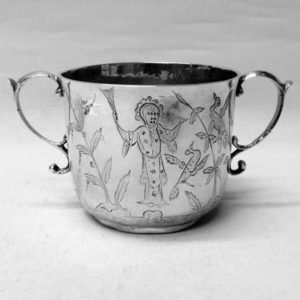
1690
8610 Antique William III Porringer
Sold
A rare early English sterling silver porringer hand engraved with the charming decoration of Chinese figures, birds, foliage etc. This chinoiserie decoration was popular over about a ten year period towards the end of the 17th century – it is rarely found and adds considerably to the piece. Excellent colour. Contains 330 ml. Weight 156 grams, 5 troy ounces. Height 7.5 cms. Spread 14.75 cms. Diameter 9 cms. London 1690. Maker TC* (see Jacksons Pickering version Page 133).
-

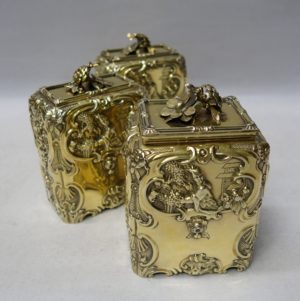
1759
Frederick Vonham
8727 Antique George II Silver Caddies
Sold
An excellent quality matching set of antique sterling silver tea jars with chinoiserie decoration and original deep gilt finish. After a Paul de Lamerie design. The matching pair of rectangular caddies (for green and black tea) have sliding tops, the larger square sugar box has a hinged lid. Cast silver flower finials. The deep embossed and engraved decoration is particularly attractive; each caddy has a front and back panel decorated with a Chinese man and garden setting, the side panels with flower and foliage, the corners with shell and fish scale ornament. Heavy weight. Total weight of 3 boxes 936 grams, 30 troy ounces. Large caddy height 14.5 cms, base 10 x 6.2 cms. Pair of caddies height 14.5 cms, base 10 x 8 cms. London 1759. Maker Frederick Vonham.
-

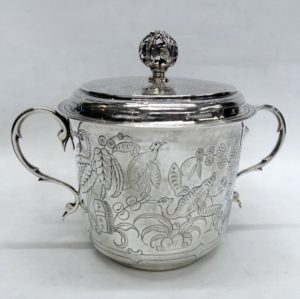
1912
Robert Frederick Fox
9235 Antique Silver Porringer and Lid
Sold
A good size sterling silver bowl and cover in the late 17th century chinoiserie style. Engraved with a charming decoration of birds and foliage. Good gauge silver. Weight 569 grams, 18.2 troy ounces. Height 15 cm (to top of finial), 10.5 (top of body). Spread across handles 19.5 cm. Diameter of bowl 12.7 cms. Both pieces hallmarked London 1912. Maker Robert Frederick Fox.
-

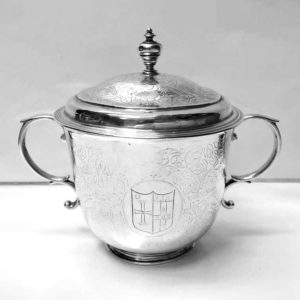
1688
Benjamin Pyne
6976 James II Antique Silver Porringer and Cover by Benjamin Pyne
Sold
A rare early English sterling silver porringer with matching lid having engraved decoration of cherubs, birds, flowers etc. This chinoiserie decoration was popular over about a ten year period – it is rarely found and adds considerably to the piece. Excellent colour. This charming piece has an armorial to the front and a crest to the reverse. This porringer was sold in 1961 by the famous silver expert Mrs G.E.P How of Pickering Place, St James, London and she describes it in the accompanying paperwork (see photos) as being “of a most unusual form” .I know of only three other examples of this work”. Weight 422 grams, 13.5 troy ounces. Height 9.5 cms, 15 cms with cover. Spread 18 cms. Diameter 11.5 cms. London 1688. Maker Benjamin Pyne.
-

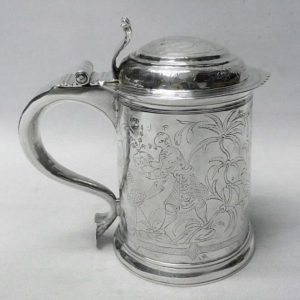
1708
Thomas Holland I
7818 Queen Anne Antique Silver Tankard
Sold
A rare and very charming early English silver lidded tankard, hand engraved with Chinese figures and exotic birds and plants. Britannia standard silver*. To the front there is a vacant plumage cartouche. The tankard has a simple flat sided form and S scroll handle finishing in a decorative thumb piece. Good patina. The interior is gilded. Contains 900 ml. Weight 561 grams, 18 troy ounces. Height 17 cms (to top of thumb piece). Diameter 9.75 cms (top), 11 cms (base). London 1708. Maker Thomas Holland I.
-

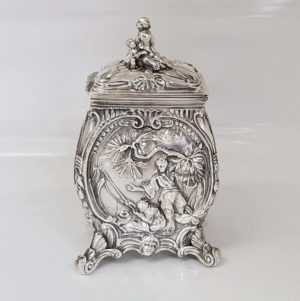
1761
Emick Romer
9755 George III Silver Chinoiserie Tea Caddy
Sold
A fine example of an antique silver caddy box of bombe form with a side hinged lid and standing on scrolling feet. The sides are embossed with charming scenes of Chinese daily life. The lid finial is in the form of a mother and baby. Weight 366 grams, 11.7 troy ounces. Height 16cm. Body measurements at maximum – width 9.2cm, depth 8cm. London 1761. Maker Emick Romer. Sterling silver.
-

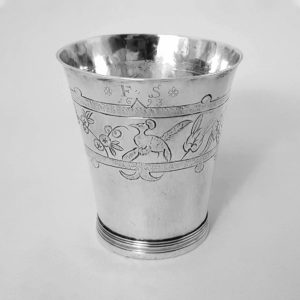
1692
John Richardson
9890 William and Mary Chinoiserie Silver Beaker
Sold
An early English antique silver beaker of plain tapering design with simple foot wires. Dating from the late 1600’s. Compact size. Charmingly decorated with a band of hand chased decoration of birds and foliage in the Chinese style known as “chinoiserie”. To the front there is a hand engraved prick dot design containing “F.S” and the date 1693. Excellent patina and hand beaten finish. Contains 160 ml. Weight 74 grams, 2.3 troy ounces. Height 8.1 cm. Diameter 7.2cm. London 1692. Maker John Richardson, a prominent cup and tankard maker known for chinoiserie silver. Sterling silver.
-

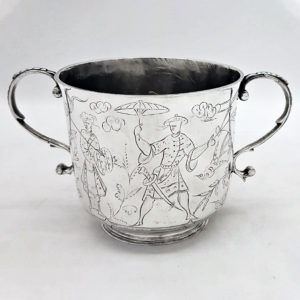
1689
Seth Lofthouse
9940 William & Mary Antique Chinoiserie Silver Porringer
Sold
A fascinating and rare piece of chinoiserie silver. This early English antique sterling silver porringer, or side handled cup, is flat chased with an exuberant oriental scene incorporating Chinese people and exotic birds. The large bowl, of circular form with flared lip, is ideal for use as a drinking cup or for displaying flowers. Weight 482 grams, 14.4 troy ounces. Height 12.3cm. Diameter 14cm. Spread across the handles 21.5cm. London 1689. Maker Seth Lofthouse. Sterling silver.
-

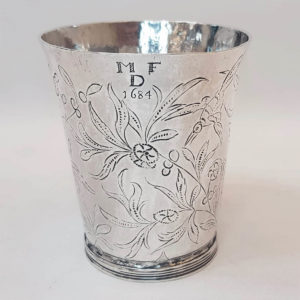
1683
John Duck
9991 Charles II Antique Silver Beaker
Sold
An early English antique sterling silver beaker of plain tapering design with simple foot wires. Dating from the late 1600’s. Charmingly flat chased with an exuberant scene of exotic birds and foliage in the Chinese style known as “chinoiserie”. To the front there are hand engraved initials “MFD” and the date 1684 and to the reverse are the prick engraved initials “CIE”. Excellent patina and hand beaten finish. Contains 290 ml. Weight 99 grams, 3.1 troy ounces. Height 9.2cm. Diameter 8cm. London 1683. Maker John Duck, well known for his fine period beakers.
-

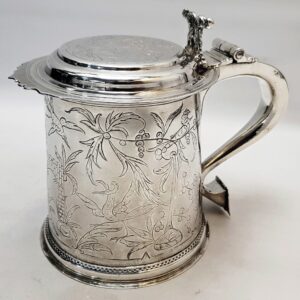
1683
St John Hoyte
10287 Charles II Antique Silver Tankard
Sold
A rare example of early English chinoiserie silver. A finely engraved tankard with the flat hinged lid and s scroll handle typical of the period. Large size and good heavy weight. The body and lid are beautifully hand chased with a fantastical Chinese landscape containing long tailed birds and spidery plants. To the front there is an extraordinary bridge with a coiled snake or rope below. Contains 1500 ml. Weight 982 grams, 31.5 troy ounces. Height 18.6cm (to top of thumb piece). Spread 21cm. Diameter 12.3cm (top). London 1683. Maker St John Hoyte. Sterling silver. 17th century.